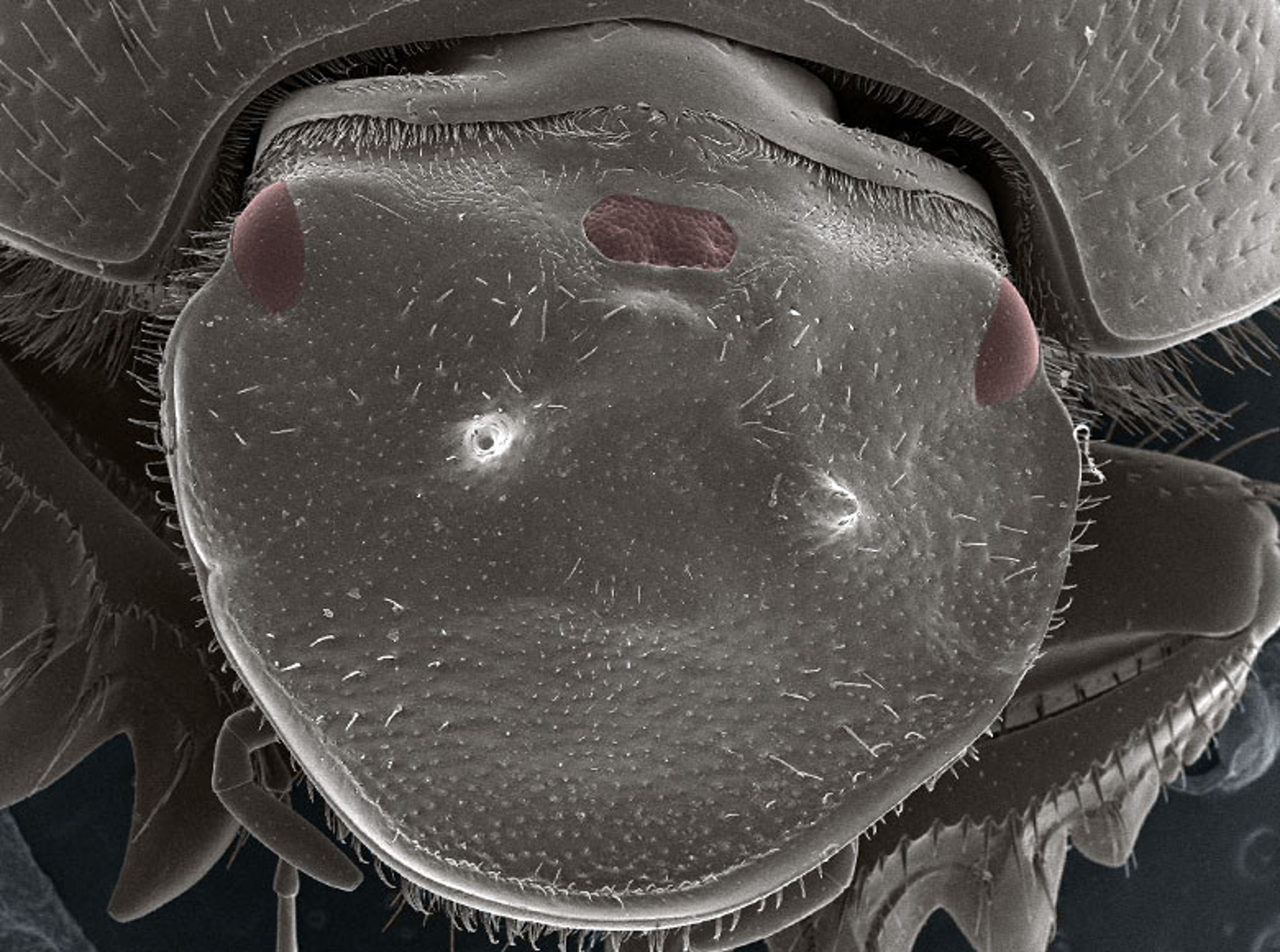
The creation of three-eyed beetles through a new technique developed at IU provides scientists a new way to investigate the genetic mechanisms responsible for the evolutionary emergence of new physical traits. Photo by Eduardo Zattara
On “Game of Thrones,” a three-eyed raven holds the secrets of the past, present and future in a vast fantasy kingdom. But for real-world biologists, a “three-eyed beetle” may offer a true glimpse into the future of studying evolutionary development.
Using a simple genetic tool, IU scientists have intentionally grown a fully functional extra eye in the center of the forehead of the common beetle. Unraveling the biological mechanisms behind this occurrence could help researchers understand how evolution draws upon pre-existing developmental and genetic “building blocks” to create novel complex traits, or “old” traits in novel places.
The study’s results appear in the journal of the Proceedings of the National Academy of Sciences. The work also provides deeper insights into an earlier experiment that accidentally produced an extra eye as part of a study to understand how the insect head develops.
“Developmental biology is beautifully complex in part because there’s no single gene for an eye, a brain, a butterfly’s wing or a turtle’s shell,” said Armin P. Moczek, a professor in the IU Bloomington College of Arts and Sciences’ Department of Biology. “Instead, thousands of individual genes and dozens of developmental processes come together to enable the formation of each of these traits.
“We’ve also learned that evolving a novel physical trait is much like building a novel structure out of Legos, by re-using and recombining ‘old’ genes and developmental processes within new contexts.”
As a consequence, the evolution of novel features often requires many fewer genetic changes than biologists originally thought.
But unlike rearranging and combining toy plastic bricks to form a new structure, Moczek said it’s unclear what biological mechanisms guide the construction of new physical traits under some circumstances but not others.
“You can make new things over and over or in new places using the same old set of ‘bricks,'” he said. “But in Legos, we know the rules of assembly: which pieces go together and which things don’t. In biology, we still struggle to understand the respective counterparts.”
One of the ways that scientists have sought to get a clearer view of this process is by coaxing the growth of “ectopic” organs – or organs that form on the wrong part of the body. Early work in the field has focused on the formation of fruit fly eyes in the wrong place, such as on the wing or leg. However, these experiments required activating major regulatory genes in the new location, a technique that is limited to only a few study organisms. The resulting “eyes” were also never fully functional.
By contrast, the new IU-led study reports on the formation of an extra functional eye — technically, a “fusion” of two sets of extra eyes — following the knockdown of a single gene, a technique widely available to scientists in most organisms. The unexpected formation of a complex, functional eye in a novel location in the process is “a remarkable example of the ability of developmental systems to channel massive perturbations toward orderly and functional outcomes,” Moczek said.
To create a fully functional eye in the center of a beetle’s head, Moczek’s team deactivated a single gene called orthodenticle, or odt, which their research has previously shown to play a role in instructing the formation of the head during development.
“This study experimentally disrupts the function of a single, major gene,” Moczek said. “And, in response to this disruption, the remainder of head development reorganizes itself to produce a highly complex trait in a new place: a compound eye in the middle of the head.
“Moreover, the darn thing actually works!”
To confirm the eye was a true extra eye, the IU team conducted multiple tests to prove the structure had the same cell types, expressed the same genes, grew proper nerve connections and elicited the same behavioral response as a normal eye. What makes the results so exciting — beyond the eye’s Frankenstein novelty — is the relatively simple genetic technique used to achieve the gene knockdown, said IU postdoctoral researcher Eduardo E. Zattara, who is lead author on the study.
Moczek said the findings also go beyond this application to help address fundamental questions in development, evolution and medicine. For example, understanding how complex organs organize their growth and integration into the body are central challenges medical sciences must overcome to develop artificial organs for research and transplantation.
“The use of ectopic eyes is a highly accessible paradigm to study all of this, across many types of organisms,” Zattara said. “We regard this study as really opening the door to new avenues of investigation in multiple disciplines.”
Additional authors on the study are Anna L. M. Macagno, a research associate, and Hannah A. Busey, an undergraduate student, in the IU Bloomington Department of Biology.




